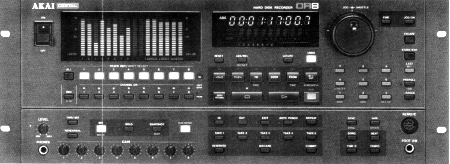
by Jerry Vigil
Akai's DR4d [April 1994 RAP Test Drive] is a slick little box, and the new DR8 is an impressive follow-up to its 4-track predecessor. Using much of the technology of the DR4d and adding a lot more features, the DR8 brings an 8-track disk-based workstation to a self contained, single rack-mount unit for only $4,995. You get an internal programmable mixer, plenty of recording time with expandability, all the basic workstation editing functions, and much more, in a fun to use unit complete with a short learning curve.
The rear panel features eight ¼-inch TRS analog input jacks that accept either balanced or unbalanced signals. LOW/HIGH output level switches (one for channels 1 and 2, one for channels 3 and 4, etc.) switch between -10dBu and +4dBu. A very nice feature of the DR8 is that these inputs are not "hard-wired" to the individual tracks. Any input can be assigned to any track! So, you could easily use just inputs 1 and 2 for all eight tracks. You also get digital inputs. The XLR and RCA digital connectors input AES/EBU and S/PDIF signals respectively. When activated, digital signals are fed to channels 1 and 2, but, again, these channels can be assigned to any track.
There are eight ¼-inch TRS analog outputs that can be used balanced or unbalanced. Four GAIN switches (one for channels 1 and 2, one for channels 3 and 4, etc.) let you adjust input to LOW (0 dB), MID (+20dB), or HIGH (+40dB). As mentioned, the DR8 sports an internal mixer, so there are analog MASTER L/R outputs. A LOW/HIGH switch sets output levels to -10dBu or +4dBu. This master mix is duplicated at the digital MASTER OUT connectors, XLR and RCA for AES/EBU and S/PDIF formats. Wrapping up the rear panel audio I/O connectors are two analog sends (also with a single HIGH/LOW output level switch for both). The sends can be set to either pre or post channel level, and they can be set as individual mono sends or as one stereo send.
Up to seven DR8s can be connected together using the REMOTE and THRU connectors on the rear panel. This enables up to 56-track operation. The SYNC connector and adjacent TERMINATOR ON/OFF switch are used to sync the DR8 with external clock sources. The SCSI-A connector is used to connect up to six external SCSI drives (or seven if there's no internal disk). Wrapping up the rear panel tour are five empty "option" slots used to install various options including the IB-802T SMPTE interface board, the IB-801S SCSI interface board, and the IB-803M MIDI interface board which enables MIDI control of many of the DR8s controls and parameters.
The front panel is a bit intimidating at first glance, but it quickly begins to make sense after a few minutes tinkering with things. The POWER ON/OFF switch is neatly recessed when ON to prevent accidental power off. To the right is the Peak Level Meter fluorescent light display (FLD). This bright display shows levels for each of the eight tracks, the two sends, the L/R Bus, and the Stereo Master levels. These bargraph meters are also used to set various parameters of the unit's internal mixer when in Mix Mode. Below this display are eight TRACK REC/INPUT SELECT keys. These are used to arm tracks for recording, and, when active, these white keys turn red. When the SUB MENU key is pressed first, these TRACK REC/INPUT SELECT keys are used to assign the input channel (1 through 8) for each track. There's also an internal stereo bus that tracks can be assigned to for bouncing tracks in the digital domain. Up to six tracks can be bounced down to two. Several keys on the front panel have other functions when the SUB MENU function is used, and these functions are easily noted on the front panel with the Sub Menu function name printed in an amber color.

